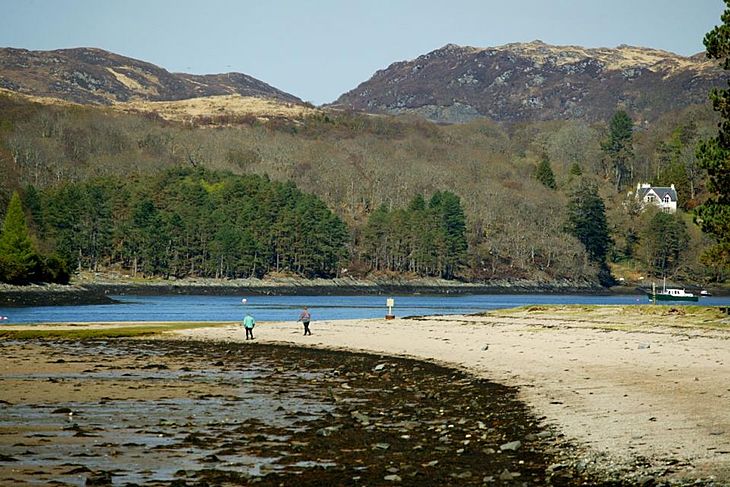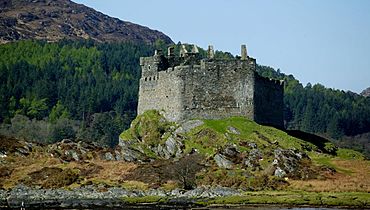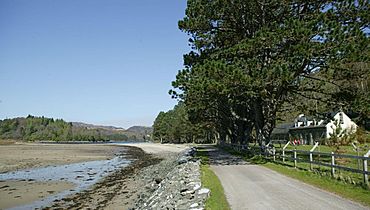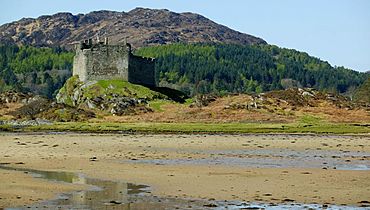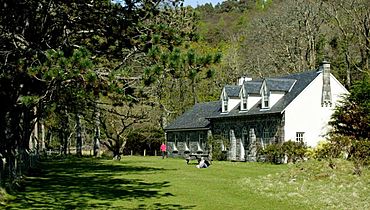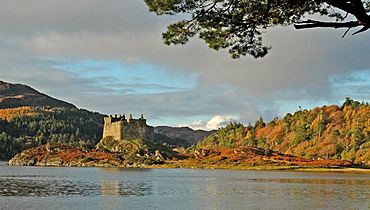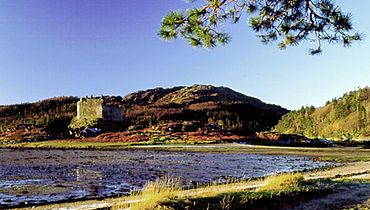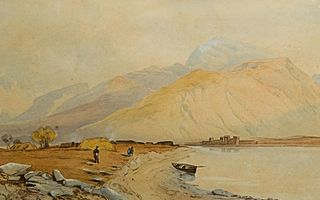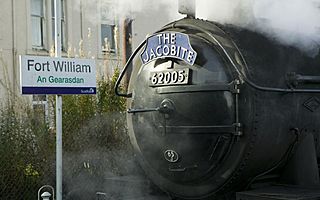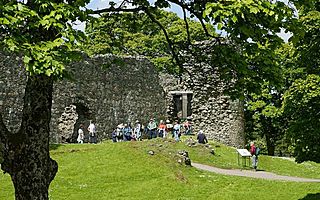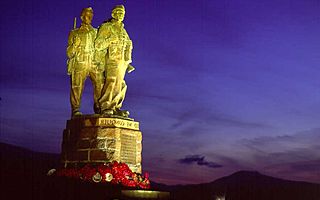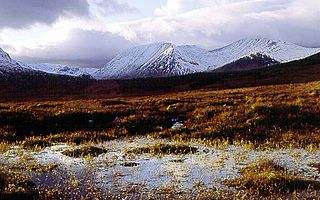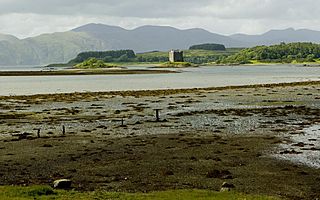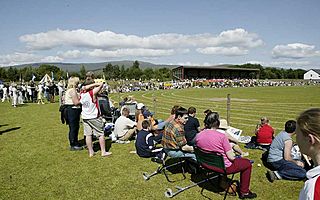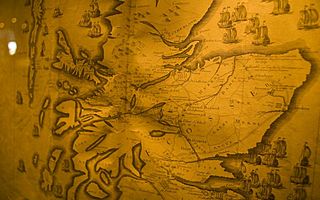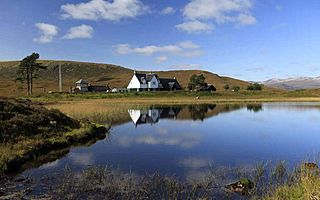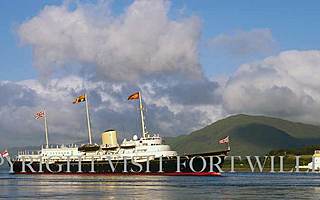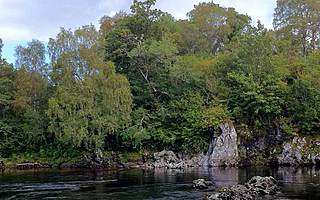Scottish Castles in the Highlands
This page tells the story of several Highland castles located in and around Fort William - castle Stalker, Old Inverlochy Castle, Tioram Castle
Fort William
The Fort in Fort William was first built by Cromwell’s forces in 1654 to pacify the local Clans, especially the Camerons. It was first known as the Garrison of Inverlochy and was just a wooden stockade on an earth bank protecting 250 troops. Together with Fort Augustus and Fort George it was the lowest outpost of a chain of Government defences intended to suppress the “savage clans and roving barbarians” as Dr.Johnson later called the locals!
An early skirmish with the Camerons at Achdalieu resulted in an English Officer having his throat bitten out!
About 1690 a substantial Fort was raised with stone walls 20 feet high, a deep dry ditch and a bomb proof magazine. The Fort then became known as Fort William named after William of Orange – and the small village which grew up nearby was Maryburgh, named after his wife.
The reinforcements were well tested in 1746 when the 600 men in the Fort were sieged by the Jacobite Army – and despite several days bombardment from the Cow Hill behind the town, it survived largely intact. As the Highland Clans were pacified and the Jacobite threat diminished the Fort became less important, but was till manned by the regular army until the Crimean War in 1854. Latterly these soldiers were used to suppress the local smuggling trade rather than fight the clans!
The Fort was later sold and dismantled and was used as the Railway Yard for the West Highland Railway when it reached Fort William in 1894. Part of the Old Fort can still be seen beside the roundabout and in front of Lochaber College. A plinth at its centre marks the start of the 73 mile "Great Glen Way" – a walk which follows the line of those early government defences to Inverness.
Fort William remains of strategic importance in the Highlands, no longer as a military stronghold but as a thriving centre of commerce and industry at the foot of Britain’s highest mountain, Ben Nevis.
Ardtornish Castle
Ardtornish Castle is at the seaward end of a promontory opposite the Village of Lochaline, where a ferry leaves for Mull. It was an important base for Clan Donald and the Lords of the Isles from the early 14th to late 15th century. Ardtornish together with the Castles of Duart and Aros in Mull are all visible from each other and would have guarded the important channel which is the Sound if Mull.
It’s been a ruin for a few centuries but is still worth the miles walk from the road end – take in the Fossil Burn en route and marvel at the scenery, moulded by lava flows – so different from the rest of the West Highlands.
Ardverikie
Ardverikie, on the edge of Lochaber, was built in the Scottish baronial style in 1870. It lies on the edge of Loch Laggan at the end of a three mile drive from the Spean Bridge Newtownmore Road, from where it is visible across the Loch. The house played host to Queen Victoria and Prince Albert for a whole month before she bought Balmoral, and more recently was popularised in the Television Series “Monarch of the Glen” as the family seat of Glen Bogle!
Though not open to the public the estate offers self catering accommodation.
Dun Dearduil – the Vitrified Fort above Glen Nevis
This ancient earthwork is accessible (by a short detour) to walkers along the West Highland Way between Blarmafoldach and Glen Nevis. It occupies a commanding point overlooking Glen Nevis*, consisting of a wall enclosing an area on a hilltop nearly 100 feet above sea level
Vitrification** is the process of fusing rocks together by some melting process requiring very high temperatures. A number of experiments, including one in Glen Nevis some years ago, have been unable to usefully recreate this process. This is one of several similar structures about the Highlands, which may be 3,000 years old. There are about sixty in Scotland, very few in England, with others in France Turkey and Iran. Their purpose remains a mystery, though recent thinking suggests they may have been local status symbols – the penthouse Suite of the Neoloithic!
There is other evidence of Vitrification in Lochaber in Arisaig, at Shielfoot near Acharacle, and on islands in Loch Arkaig and in Loch Ailort.
Glenborrodale Castle
This mock baronial Castle was built to replace an earlier house for Charles Dunell Rudd, a vastly rich diamond magnate and close friend of Cecil Rhodes in 1898. It is built of Annan Sandstone and was once owned by Jesse Boot who was the proprietor of the Boots chain of chemist shops.
It now offers luxury accomodation for small parties and weddings. A new distillery is about to open on the site.
Inverailort House or Castle
This Georgian Mansion is a private house, dating from 1875, and in need of restoration. It was the home of the late Mrs Cameron Head, a delightful eccentric who kept open house to local youth groups and contributed much to the local community.
Its importance is its place as the first Training Base of the elite Military Unit in 1940 who later became known as the Commandos, now a term recognised world wide as a mark of military excellence. The Cameron Heads received notification by letter that the house was to be taken over “ for unspecified purposes” and took up residence in a room at Lochailort Inn.
Meantime the specialist fighting talents of William Fairburn and Eric Sykes were commandeered to train the soldiers. They had honed their skills in self defence (largely by attack!) in the Shanghai Police, and the famous Commando “Fairburn-Sykes” Knife was perfected with the help of Messrs Wilkinson Sword of London in 1940. It’s principal aim was “silent killing”.
The unarmed combat program at Inverailort carried a warning….”The “Japanese Strangle”, the edge of the hand blows and the arm throw require extreme care. On NO ACCOUNT should the Chinese “rock crusher” be practised over the heart”.
Invergarry Castle
Invergarry Castle, now an iconic ruin, was the seat of the Chiefs of the MacDonells of Glengarry, a powerful branch of the Clan Donald, known as the Clan Ranald of Knoydart and Glengarry. Its situation on Creagan an Fhithich - the Raven's Rock - overlooking Loch Oich in the Great Glen, was a strategic one in the days of clan feuds and Jacobite risings.
It is easily found alongside the drive to Glengarry Castle Hotel, just South of Invergarry on the A82. It was first burnt down by General Monck, stationed in Fort Willam about 1654 and the ruins once housed the Invergarry Iron Works, which when abandoned in the 1730’s left a number of “Iron Pigs”, which to this day are still apparent as grave markers in the area.
Inverlochy Castle Hotel
Inverlochy Castle Hotel was once the mansion of the Abinger family. James Scarlett was the son of the first Lord Abinger, immortalised as being the General Scarlet who led the Charge of the Heavy Brigade at the Battle of Balaklava in 1854.
The Abingers rebuilt it in 1863 and were honoured by the presence of Queen Victoria for a week in 1873. She was house hunting at the time and looked at Ardverikie Castle as a future residence – the tale has it however that the weather was so atrocious she took off to the east and bought Balmoral instead! Nevertheless she commented 'I never saw a lovelier or more romantic spot'.
The Castle remained in the family for many years but was bought by Joseph Hobbs after the second war together with much of the lower Great Glen. “Jo Hobbs” opened a cattle ranch based on his experiences in Canada and the Cattle Shelters are still very visible along the A82 between Fort William and Spean Bridge.
His daughter in law Grete Hobbs opened the Castle as a country house hotel in 1969 and it has since become a world famous venue for the rich and famous, winning multiple awards for its cuisine and accommodation.
Mingarry Castle
Follow the long single track road towards the most Westerley point of the British mainland at Ardnamurchan point – and you can take a short 10 minute walk to Mingarry Castle*. Situated on a headland 1 mile from Kilchoan it stands above the sea overlooking Loch Sunart and the isle of Mull. The castle was built in the 13th cent but most of the remaining structure dates from the 16th and 18th centuries. The castle was once the seat of the MacIeans. King James IV stayed here when he tried to control the MacDonalds in the 15th cent, and it went on changing hands until in 1696 Alexander Campbell improved the castle, hiding most of the 13th cent. structures. Hanovarian troops were garrisoned here during the Jacobite Rebellion of 1745. In 1746 the Jacobite MacDonalds of Glencoe surrendered here to the Campbells. The castle was probably in use until the 1850's, but slowly fell into the ruin we see today.
Castle Stalker
This four story tower house or keep is one of the most photographed sites in the Highlands, being set on a tidal islet off an inlet off Loch Linnhe, about 1.5 miles (2.5 km) north east of Port Appin. Despite its high profile, it remains one of the best-preserved medieval tower-houses surviving in western Scotland. The original castle was a small fort, built around 1320 by Clan MacDougall who were then Lords of Lorn. The Stewarts rebuilt the castle in its present form around the 1440s. There are stories of arguments, murders, hunting visits by the Stewart's relative King James IV of Scotland and a drunken bet around 1620 resulting in the castle passing to Clan Campbell. The Campbells finally abandoned the castle around 1840, when it lost its roof. Then in 1908 a Stewart bought the castle and carried out basic conservation work, and in 1965 Lt. Col. D. R. Stewart restored it as a habitable house. The Castle is open for short spells in the Summer – follow the link for details*
* http://www.castlestalker.com/
Castle Tioram
This Castle at Dorlin* is sited magnificently on a rocky tidal island close to the mouth of the River Shiel near Acharacle. It would have been an important site long before the Castle is first recorded in the 14th Century. Excavation has suggested Viking presence interest and there is a seventh century bronze hanging bowl in the West Highland Museum which was found in 1928 during reconstruction. It remained the seat and power base of the MacDonalds of ClanRanald for most of its useful life. Successive chiefs gained a reputation for wild ruthless behaviour, one described as consecrating his life to plunder and rapine whilst Donald, the 13th chief, became notorious for his cruel, savage, unreasoning autocratic behavior. Tis’ told that as an elderly man John enjoyed sitting on the ramparts of the castle taking shots with his favorite gun "the cuckoo" at anything that moved, human or otherwise! It was already a near ruin by 1715 when it was torched by Allan MacDonald, the 14th Chief of ClanRanald when he left for the battle of Sheriffmuir, supposedly with a premonition that he would not return. He was fatally wounded there.
It has recently been the subject of an enquiry regarding its rebuilding and remains inaccessible for close examination – though the ramparts can be closely examine at low tide!
Torcastle
Little is left of this once fine stronghold overlooking the River Lochy about 4 miles from Fort William. The little that is left is much overgrown, though the grandeur of the site remains above the Cat Pool ( Buinne a’Chait), where the King of the Cats was once roasted on a spit! They are accessed through a tunnel, built by Telford, under the Caledonian Canal at Shenghan. Put your lights on as drive under the canal – or walk in your welly boots!
There have been several Castles here for the best part of a thousand years with MacPhersons, MacKintosh’s and Camerons all holding sway over the centuries. It was probably last rebuilt about 1530 by the Camerons who in the next century moved to Achnacarry where the seat of Clan Cameron, Achnacarry Castle remains today.
